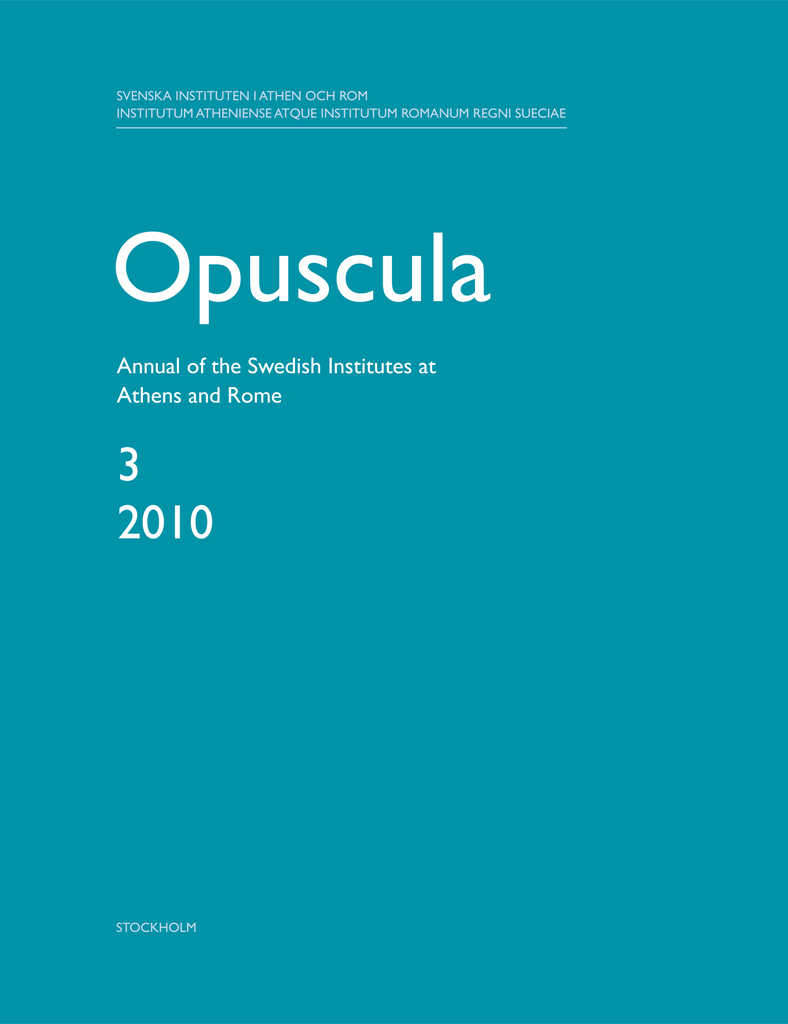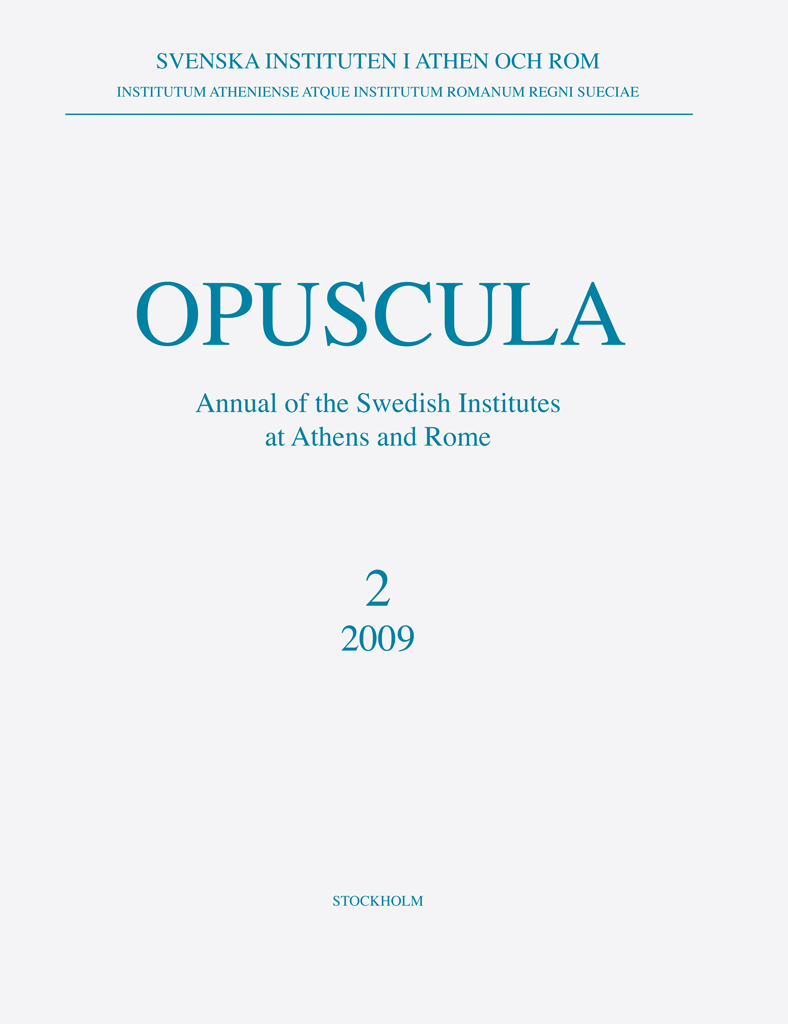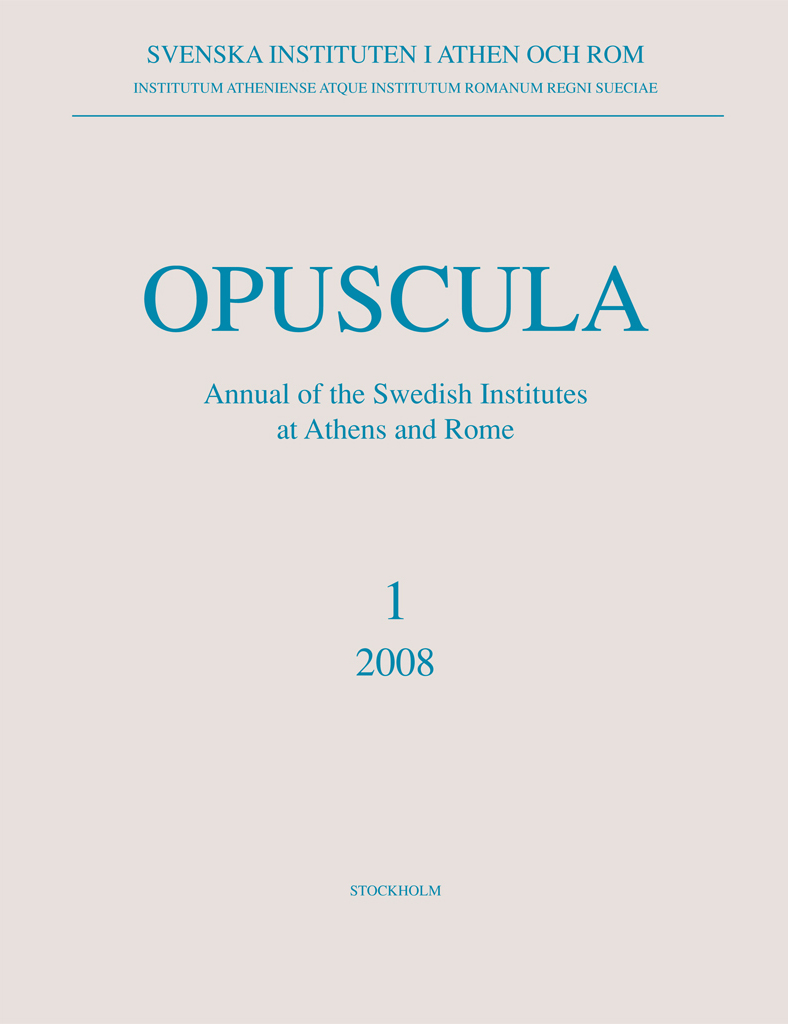Opuscula 3 (2010) is now available for purchase and free download at Bokorder.se. Also available at Amazon.com, Amazon.de, Bokus.com, and Adlibris.com. Excavations in Midea 2008–2009 By Katie Demakopoulou, Nicoletta Divari-Valakou, Maria Lowe Fri, Madeleine Miller, Monica Nilsson & Ann-Louise Schallin Abstract Excavations in Midea continued in 2008 and 2009 as a Greek-Swedish programme under the direction of Dr Katie Demakopoulou in collaboration with Dr Ann-Louise Schallin. On the lower west terrace of the Acropolis excavation continued in Trench C in order to conclude the investigation of the syrinx discovered in 2007. A small trench was opened in the interior of Room I to examine the deposit below its floor. Furthermore, the cleaning of a large area outside the north section of the citadel wall brought to light a large part of a massive terrace wall. Investigations were made in three adjacent locations in the area east of the East Gate: in the baulk between Trenches 3 and 9, in Trench 9S and in Trench 12. As a result of these excavations new walls were discovered, which add to our previous knowledge of the layout of the series of rooms in this area, abutting the fortification wall. The finds include fragments…
Opuscula 2 (2009) is now available for purchase and free download at Bokorder.se. Also available at Amazon.com, Amazon.de, Bokus.com and Adlibris.com. Decorative effects and room functions. The evidence of thresholds studied in the residential quarters of Insula V 1, Pompeii By Thomas Staub Abstract The present paper discusses the use of different types of thresholds in the Pompeian domestic architecture. The considerations proceed from observations made in three larger dwellings in Insula V 1 in Pompeii, the town quarter, which is under current investigation by the Swedish Pompeii Project. The thresholds are considered in the contexts of corresponding pavements and wall decorations as well as that of the related rooms. Differences will be studied between the areas around the atria and the zones around the peristyles. They indicate that while the thresholds around the atrium are of a homogeneous character, defined by the shape and decorations of the central room, the ones around the peristyle are defined by the decorations and dignity of each particular room opening up towards the central entity. It seems also that both the material used and the shape of the thresholds could be dependent on the taste defining the decorations, either of the floor or…
Opuscula 2 (2009) is now available for purchase and free download at Bokorder.se. Also available at Amazon.com, Amazon.de, Bokus.com and Adlibris.com. A tale of three drums: an unfinished Archaic votive column in the Sanctuary of Poseidon at Kalaureia By Jari Pakkanen Abstract Three unfinished column drums discovered at the Kalaureia Research Program excavations in 2007–2009 can be shown to have been intended for a monumental Archaic Ionic votive column. All drums have systematic masons’ marks on the contact surfaces. The latter parts of the inscriptions indicate the position of the drum in the shaft. Two alternative readings for the first part of the inscription are suggested: the first interprets it as a building instruction and the second as a price indication. The start of the building project took place very likely in the second half of the sixth century BC, and the deposit date of the fill surrounding the blocks indicates that the unfinished project was abandoned in the late sixth century BC. Reconstruction of the column shaft from the known drum dimensions demonstrates that the finished shaft would have been constructed with a slight entasis. Bibliographical information Jari Pakkanen, ‘A tale of three drums: an unfinished Archaic votive column…
Opuscula 2 (2009) is now available for purchase and free download at Bokorder.se. Also available at Amazon.com, Amazon.de, Bokus.com and Adlibris.com. A new inscribed statue base from the Sanctuary of Poseidon at Kalaureia By Jenny Wallensten & Jari Pakkanen Abstract In the Kalaureia Research Program excavations of 2007 and 2008, four joining blocks of a statue base were unearthed. The monument is a dedication from the polis of Arsinoe in the Peloponnese: its inhabitants offered two statues, of King Ptolemaios and his sisterwife Arsinoe Philadelphos, to Poseidon. The present article publishes the monument and its inscription, and proceeds to present a reconstruction and an attempt at positioning the monument in its historical context. Bibliographical information Jenny Wallensten & Jari Pakkanen, ‘A new inscribed statue base from the Sanctuary of Poseidon at Kalaureia’, Opuscula. Annual of the Swedish Institutes at Athens and Rome (OpAthRom) 2, 155–165. Stockholm 2009. ISSN: 2000-0898. ISBN: 978-91-977798-1-4. Softcover, 232 pages. https://doi.org/10.30549/opathrom-02-07
Opuscula 2 (2009) is now available for purchase and free download at Bokorder.se. Also available at Amazon.com, Amazon.de, Bokus.com and Adlibris.com. A smiting-god-figurine found in the Sanctuary of Poseidon at Kalaureia By Berit Wells & Andreas Karydas Abstract In 2007 a Reshef figurine was found in a secondary context southeast of the Temple of Poseidon at Kalaureia. This article discusses its origin in the Syro-Palestinian area in the thirteenth century BC and suggests it arrived at Kalaureia towards the end of the Late Bronze Age and was deposited in a sacral context. As Reshef in later history was identified with Apollo in the Greek environment, the author speculates on there being perhaps a kernel of truth in the later myth of Apollo and Poseidon having exchanged dwelling places in the hoary past. The peculiar surface of the piece called for a technical analysis, which was carried out by Andreas Karydas from the Institute of Nuclear Physics, Demokritos, Athens. It clarified that the “pock marks” on the surface stem from the manufacturing process and are not the result of corrosion. Bibliographical information Berit Wells & Andreas Karydas, ‘A smiting-god-figurine found in the Sanctuary of Poseidon at Kalaureia’, Opuscula. Annual of the…
Opuscula 2 (2009) is now available for purchase and free download at Bokorder.se. Also available at Amazon.com, Amazon.de, Bokus.com and Adlibris.com. Report on the excavations in the years 2007 and 2008 southeast of the Temple of Poseidon at Kalaureia By Arto Penttinen and Berit Wells (†). With contributions by Dimitra Mylona, Petra Pakkanen, Jari Pakkanen, Arja Karivieri, Anne Hooton and Emanuel Savini, and with an appendix by Tatiana Theodoropoulou. Abstract Archaeological material ranging in date from the Early Bronze Age to Late Antiquity was found in 2007 and 2008 in the excavations in Area H to the south and southeast of the Temple of Poseidon. Finds datable to the periods of major change in the Sanctuary—the Late Archaic and the Early Hellenistic—illuminate the character of the change. In the Late Archaic period an attempt to erect a votive column at the site was for some reason given up, and drums of large dimensions were left visible, possibly as a reminder of the failure. The construction of a monumental drain next to the Archaic peribolos of the Temple of Poseidon in the early third century BC necessitated large-scale leveling work in the area coinciding in time with the dedication of a…
Opuscula 2 (2009) is now available for purchase and free download at Bokorder.se. Also available at Amazon.com, Amazon.de, Bokus.com and Adlibris.com. Labraunda 2008. A preliminary report on the Swedish excavations By Lars Karlsson, Jesper Blid & Olivier Henry Abstract The Swedish archaeological project at the Karian sanctuary of Zeus Labraundos celebrated, in 2008, sixty years of work. The year 2008 was very special, both because of these celebrations, but also because of the important finds that came to light during the excavation of the unusual Roman bath that was discovered in 2007. It is built in the shape of a four-leaf clover (the so-called Tetraconch), and can be dated to the first half of the fourth century AD. A large amount of finds were discovered, including superb pieces of plates in African Red Slip and Late Roman C wares, a water flask, and coloured marble pieces. In the necropolis, we excavated another 19 rock-cut tombs. The finds from these include a golden ring with a cornelian stone and 22 gold appliqués in the shape of rosettes and palmettes. The appliqués had four holes to fasten them to the drapery of the deceased. They are very similar to appliqués found in…
Opuscula 2 (2009) is now available for purchase and free download at Bokorder.se. Also available at Amazon.com, Amazon.de, Bokus.com and Adlibris.com. Radiocarbon analysis and the history of the East Cemetary, Asine By Sofia Voutsaki, Søren Dietz & Albert J. Nijboer Abstract This paper presents the results of the radiocarbon analysis of human bones from the East Cemetery (IQ tumulus), Middle Helladic Asine. The analyses have been carried out at the Centre for Isotope Research, University of Groningen, using the AMS (Accelerator Mass Spectroscopy) method. The main aim of the analysis is to elucidate the history of use of the tumulus and the surrounding extramural cemetery by comparing the absolute dates with the relative dates based on the ceramic offerings and the internal stratigraphy of the tumulus. The establishment of a formal disposal area and the adoption of the tumulus are significant developments in the MH period, and it is therefore important to date their appearance with more precision. In addition, a more accurate reconstruction of the history of this important funerary monument gives us a better understanding of mortuary practices and social change in Asine, and in the MH mainland in general. This contribution is only available in print. Bibliographical…
Opuscula 2 (2009) is now available for purchase and free download at Bokorder.se. Also available at Amazon.com, Amazon.de, Bokus.com and Adlibris.com. Excavations in Midea 2007 By Katie Demakopoulou, Nicoletta Divari-Valakou, Monica Nilsson & Ann-Louise Schallin Abstract Excavations in Midea continued in 2007 as a Greek-Swedish programme under the direction of Dr Katie Demakopoulou in collaboration with Dr Ann-Louise Schallin. In the West Gate area excavation continued in the west part of the building complex that abuts the fortification wall. Room XIV was excavated with abundant remains of LH IIIB2 pottery. A sealstone with a unique, possibly ritual, scene was also found. On the lower west terrace of the acropolis excavation continued in Trench C, where a large section of the fortification wall was uncovered. Room I was excavated here, adjacent to the inner face of the fortification wall. Finds in this room date to the early phase of LH IIIC, under which there was ample evidence of the LH IIIB2 destruction, including human skeletons. Under this debris, a large opening leading to a gallery or syrinx through the thickness of the fortification wall was found. Excavation was resumed also in the East Gate area, where a new wall was revealed…
Opuscula 1 (2008) is out of print. Available for free download at Bokorder.se. Used copies might be available at Amazon.com and Amazon.de. Excavations in Midea 2006 By Katie Demakopoulou, Nicoletta Divari-Valakou, Monica Nilsson, Ann-Louise Schallin & Kalliopi Nikita Abstract Excavations in Midea continued in 2006 as a Greek-Swedish programme under the direction of Dr. Katie Demakopoulou in collaboration with Dr. Ann-Louise Schallin. In the Upper Acropolis remains of an Early Helladic II defensive system were uncovered. East of this and at a lower level, a floor deposit was excavated with abundant pottery of Early Helladic I date including typical examples of the Talioti Ware. In the West Gate area excavation continued in the west part of the building complex adjacent to the fortification wall. Abundant Late helladic IIIB2 pottery was recovered from the exploration of two more rooms of the complex. A new trench was opened on the lower west terrace of the Acropolis in order to expose the line and the entire width of the fortification wall, which is almost completely covered by accumulated deposits in this area. Excavation was resumed in the East Gate area with the removal of a wide baulk and the investigation of the space…



